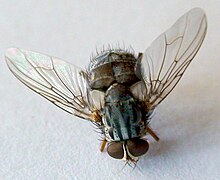| Philornis downsi | |
|---|---|
 | |
| Scientific classification | |
| Domain: | Eukaryota |
| Kingdom: | Animalia |
| Phylum: | Arthropoda |
| Class: | Insecta |
| Order: | Diptera |
| Family: | Muscidae |
| Genus: | Philornis |
| Species: | P. downsi |
| Binomial name | |
| Philornis downsi Dodge & Aitken, 1968 [1] | |
| Synonyms | |
| |
Philornis downsi, also known as the avian vampire fly, [2] is a species of fly (Diptera, Muscidae) that was first recorded in Trinidad and Brazil in the 1990s. [3] It has been accidentally introduced to the Galapagos Islands (Ecuador). Adults of P. downsi feed on fruit. Eggs are laid in bird nests and hatch into parasitic larvae that reside in the nest material and emerge at night to feed both internally and externally on the blood and flesh of developing nestlings. [4] The parasite causes significant mortality in Darwin's finch nestlings and threatens the survival of some rarer species such as the mangrove finch (Camarhynchus heliobates) and the medium tree finch (C. pauper). [5] [6] [7] [8] To protect the threatened finch populations, insecticide-laced cotton has been supplied as nesting material for the finches, with the results being highly successful in combating P. downsi infestations at a localized scale. [9] Currently, Biological pest control agents, including Conura annulifera, are being investigated for their potential safety and efficacy in eradicating P. downsi on the Galapagos Islands. [10]